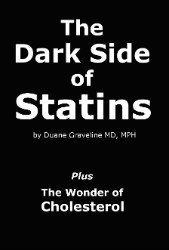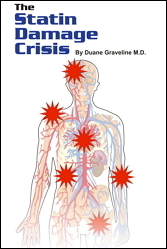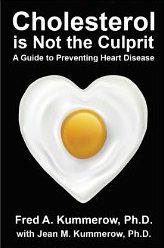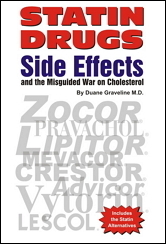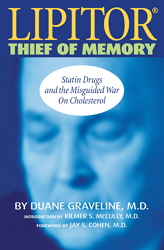The Truth About Cholesterol
 By Duane Graveline MD, MPH
By Duane Graveline MD, MPH
Cholesterol became an important evolutionary player eons ago when simple one-celled organisms, resembling bacteria, began evolving into complex multi-cellular organisms in which each cell contained a nucleus. The complexity of animal cells today would not be possible without all the membrane structures that define the components of cells.
The nucleus, the mitochondria, the cell walls, the Golgi apparatus and endoplasmic reticulum, all wrapped by this functionally active membrane that controls all traffic into and out of the cell. A very special molecule was necessary for this challenging job. Only one biochemical was uniquely suitable for this role - we call it cholesterol.
For the past four decades we have all been subjected to an intense and carefully calculated program of brainwashing to believe that cholesterol is our enemy. I am sorry to admit that I was one of thousands of doctors trained to absorb this propaganda without question. In retrospect I am angry to have been so completely enmeshed in this web of deceit.
Like puppets we wrote millions of prescriptions for whatever cholesterol buster the drug companies were promoting at the time. I was just like all the other doctors - doing what I was told, never suspecting we had functionally become employees of the pharmaceutical industry. In truth there has never been a scientific study that has been able to demonstrate a causal link between cholesterol and heart disease. The reality is that cholesterol in its natural form cannot be harmful.
Far from being harmful, cholesterol is perhaps the most important biochemical in our bodies. I suppose it was those rabbit studies that "proved" cholesterol causation for me. In this 1955 era study someone demonstrated that if you fed rabbits cholesterol enriched pellets they got severe atherosclerosis. If you took away the cholesterol enrichments, the atherosclerosis went away. If you restarted the cholesterol enrichment, the atherosclerosis reappeared.
What better proof could one have? What more did I need? The truth was not to be revealed to me until 1999 when Kilmer McCully's The Homocysteine Revolution explained it all for me. Natural cholesterol is harmless Kilmer wrote, but if you allow it to sit around uncovered it rapidly becomes oxidized to its oxy-cholesterol cousin which is highly toxic. He went on to describe how he could inject natural cholesterol into arteries with impunity but to inject oxy-cholesterol created atherosclerosis every time.
The explanation was so simple. Now, a decade later, doctors are finally awakening as if from a bad dream wondering how for the past 40 years they could have been giving their patients the wrong advice about cholesterol.
Pfrieger's landmark publication in 2003 on the vital role of cholesterol in the formation and function of memory synapses has been followed by one research report after another documenting the importance of cholesterol. The wide ranging demand for cholesterol in so many of our vital bodily functions including nerve, muscle and even personality has been well documented.
Almost all our cholesterol is found in cell membranes. An average of 20% of all the molecules in our cellular membranes is cholesterol. Over the past decade there has been a huge increase in research publications documenting the action of cholesterol-rich structures within these membranes.
Lipid research now describes an amazingly busy schedule for these membrane-cholesterol molecules. Saying that, "Our bodies run on cholesterol," comes very close to describing what has been learned in just the past few years.
With the emergence of the cholesterol-rich lipid raft observations, the role of cholesterol in cell recognition and communication has been established. That cholesterol strengthens and stabilizes the functional areas of the cell membrane has been demonstrated.
The role of cholesterol in exocytosis and endocytosis has only recently been established. Exocytosis is the process by which a cell guides the contents of secretory vesicles out of the cell membrane as lipid wraps. These lipid wraps (membrane-bound vesicles) contain soluble proteins and lipids destined for functions outside of the originating cell. Endocytosis is the process by which cells absorb these lipid wraps and the molecules they carry (such as proteins) from outside the cell by engulfing it within their cell membrane, amoeba fashion.
Cholesterol in the cell membrane also protects the cells' contents from leakage and loss. This is important when the cell stores energy, ready for some activity like thought (neuron) or exercise (muscle cell). The process of creating energy in all cells is dependent upon what is called electrochemical gradients; the accumulation of sodium ions or protons on one side of the membrane compared to the other, by pumping action through specialized membrane pores.
If ATP ( adenosine triphosphate ) is the gasoline that fuels our cells, sodium electrochemical gradients are the basis of the process that makes the ATP. The accumulation of sodium ions is accompanied by a natural leakage rate. The reason for the cholesterol-rich layer of lipids in these plasma membranes is to prevent this leakage by serving as what amounts to an insulator.
Biochemist Thomas Haines proposed in 2002 that cholesterol is a key inhibitor of sodium ion leakage. Low cholesterol or any process that artificially lowers membrane cholesterol below natural limits must interfere with ATP production.
Of particular interest is Haines' discovery that cholesterol's role in electro-chemical gradient leakage control is quite comparable to that of both CoQ10 and dolichols. Haines maintains that dolichols are responsible for leakage control of lysosomes (our intracellular disposal units) and ubiquinone (CoQ10) serves as leakage control for our mitochondrial sodium ion.
Since statin drugs inhibit the synthesis of all three of these lipids (cholesterol, dolichol and ubiquinone) by the mevalonate blockade common to all reductase inhibitors, this work of Haines and other biochemists serves to document the inevitability of both mitochondrial damage and energy loss associated with statin use.
Indeed it is unfortunate that this information was not available to the developers of the reductase inhibitor class of drugs. Tens of thousands of statin side effects claims have been dismissed as "to be expected at your age."
You can imagine that in the case of neurons and nerves, all the electrical activity transmitted down the connecting axons requires an elaborate containment of impulse and defense against burn out (oxidation).
Our neurons and nerves have evolved a protective wrapping of myelin. This myelin is continuously maintained by specialist cells. Oligodendrocytes maintain the myelin wrapping for the neurons and Schwann cells maintain the myelin sheathing for our nerves. Myelin is made up of about 40% cholesterol molecules and cholesterol is a very good insulator and antioxidant.
Paul Ridker discussed the effects of statin therapy on incident diabetes, having presented data showing that statins significantly promote diabetes in 6 out of the 7 trials he reviewed. Our internal insulin supply is facilitated by cholesterol and recently Xia and co-workers demonstrated a causal link between membrane cholesterol lowering and the impairment of insulin granule release.
The impairment of the exocytosis of myelin has been cited as an explanation of the reduced myelination of glial cells and Schwann cells (a form of glial cell responsible for the myelination of nerve fibers (as in multiple sclerosis).
The maintenance and repair of neurons and nerves requires huge amounts of cholesterol. Neural systems have significant vulnerability to cholesterol depletion through the reduction in the synaptic exocytosis and endocytosis of essential signaling lipoproteins. The diminished exocytosis of neuromuscular junction (Agrin, LRP4 and MuSK) enzyme secretions has implications in the etiology of neuromuscular junction disease (ALS).
Cholesterol is not only the most common organic molecule in the brain, it is also distributed intimately throughout the entire body. Additionally, cholesterol is the precursor for a whole class of hormones known as the steroid hormones that are absolutely critical for life as we know it. Such hormones include estrogen, progesterone, testosterone, aldosterone, cortisol and calcitrol (vitamin D). These hormones determine our sexuality, control the reproductive process, and regulate blood sugar levels and mineral metabolism.
Beyond this, there is yet another class of cholesterol's steroid offspring without which our metabolic well-being might be in serious jeopardy: the production of bile acids. Bile makes it possible for us to emulsify fats and other nutrients. Without bile, we could not digest and absorb the fats in our diet and would slowly starve.
We must also note that HMG-CoA reductase, the key enzyme target for statin use, is found in the membrane walls of the endoplasmic reticulum and the mitochondrial wall. These cell membranes contain between 20% and 50% cholesterol molecules.
The large amounts of cholesterol required for both the formation and function of these basic structures argues strongly against the rationality of excessively liberal use of drugs such as statins that inhibit cholesterol synthesis.
Duane Graveline MD MPH
Former USAF Flight Surgeon
Former NASA Astronaut
Retired Family Doctor
January 2011


